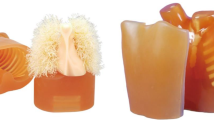Abstract
Size and density measurements of objects undertaken using computed tomography (CT) are clinically significant for diagnosis. To evaluate the accuracy of these quantifications, we simulated three-dimensional (3D) CT image blurring; this involved the calculation of the convolution of the 3D object function with the measured 3D point spread function (PSF). We initially validated the simulation technique by performing a phantom experiment. Blurred computed images showed good 3D agreement with measured images of the phantom. We used this technique to compute the 3D blurred images from the object functions, in which functions are determined to have the shape of an ideal sphere of varying diameter and assume solitary pulmonary nodules with a uniform density. The accuracy of diameter and density measurements was determined. We conclude that the proposed simulation technique enables us to estimate the image blurring precisely of any 3D structure and to analyze clinical images quantitatively.









Similar content being viewed by others
References
Blake ME, Soto JA, Hayes RA, Ferrucci JT (2005) Automated volumetry at CT colonography: a phantom study. Acad Radiol 12:608–613
Boone JM (2001) Determination of the presampled MTF in computed tomography. Med Phys 28:356–360
Dougherty G, Newman D (1999) Measurement of thickness and density of thin structures by computed tomography: a simulation study. Med Phys 26:1341–1348
Fischbach F, Knollmann F, Griesshaber V, Freund T, Akkol E, Felix R (2003) Detection of pulmonary nodules by multislice computed tomography: improved detection rate with reduced slice thickness. Eur Radiol 13:2378–2383
Ishikawa H, Koizumi N, Morita T, Tani Y, Tsuchida M, Umezu H, Naito M, Sasai K (2005) Ultrasmall pulmonary opacities on multidetector-row high-resolution computed tomography: a prospective radiologic−pathologic examination. J Comput Assist Tomogr 29:621–625
Jeong YJ, Lee KS, Jeong SY, Chung MJ, Shim SS, Kim H, Kwon OJ, Kim S (2005) Solitary pulmonary nodule: characterization with combined wash-in and washout features at dynamic multi-detector row CT. Radiology 237:675–683
Kalender WA (2005) Computed tomography. 2nd revised edn. Erlangen, Germany
Marchand EW (1964) Derivation of the point spread function from the line spread function. J Opt Soc Am 54:915–919
Meinel JF Jr, Wang G, Jiang M, Frei T, Vannier M, Hoffman E (2003) Spatial variation of resolution and noise in multi-detector row spiral CT. Acad Radiol 10:607–613
Okubo M, Wada S, Saito M (2005) Validation of the blurring of a small object on CT images calculated on the basis of three-dimensional spatial resolution. Igaku Butsuri 25:132–140
Ohkubo M, Wada S, Matsumoto T, Nishizawa K (2006) An effective method to verify line and point spread functions measured in computed tomography. Med Phys 33:2757–2764
Prevrhal S, Engelke K, Kalender WA (1999) Accuracy limits for the determination of cortical width and density: the influence of object size and CT imaging parameters. Phys Med Biol 44:751–764
Prevrhal S, Fox JC, Shepherd JA, Genant H K (2003) Accuracy of CT-based thickness measurement of thin structures: modeling of limited spatial resolution in all three dimensions. Med Phys 30:1–8
La Rivière PJ, Pan X (2002) Pitch dependence of longitudinal sampling and aliasing effects in multi-slice helical computed tomography (CT). Phys Med Biol 47:2797–2810
La Rivière PJ, Pan X (2002) Anti-aliasing weighting functions for single-slice helical CT. IEEE Trans Med Imaging 21:978–990
Rollano-Hijarrubia E, Stokking R, van der Meer F, Niessen WJ (2006) Imaging of small high-density structures in CT: a phantom study. Acad Radiol 13:893–908
Schwarzband G, Kiryati N (2005) The point spread function of spiral CT. Phys Med Biol 50:5307–5322
Swensen SJ, Viggiano RW, Midthun DE et al (2000) Lung nodule enhancement at CT: multicenter study. Radiology 214:73–80
Teo BK, Seo Y, Bacharach SL, Carrasquillo JA, Libutti SK, Shukla H, Hasegawa BH, Hawkins RA, Franc BL (2007) Partial-volume correction in PET: validation of an iterative postreconstruction method with phantom and patient data. J Nucl Med 48:802–810
Wada S, Takahashi K, Katada T, Tsuchimochi M (1998) An analytical method for precise measurements of cortical bone thickness using CT image - dual mode LSF analysis and its precision. CAR’98 Comp Assist Radiol Surg, Tokyo, pp. 63–67
Wang G, Vannier MW (1994) Spatial variation of section sensitivity profile in spiral computed tomography. Med Phys 21:1491–1497
Wiemker R, Rogalla P, Blaffert T, Sifri D, Hay O, Shah E, Truyen R, Fleiter T (2005) Aspects of computer-aided detection (CAD) and volumetry of pulmonary nodules using multislice CT. Br J Radiol 78:S46–S56
Wormanns D, Kohl G, Klotz E, Marheine A, Beyer F, Heindel W, Diederich S (2004) Volumetric measurements of pulmonary nodules at multi-row detector CT: In vivo reproducibility. Eur Radiol 14:86–92
Yankelevitz DF, Reeves AP, Kostis WJ, Zhao B, Henschke CI (2000) Small pulmonary nodules: Volumetrically determined growth rates based on CT evaluation. Radiology 217:251–256
Acknowledgments
This study was supported in part by a Grant-in-Aid for Cancer Research (Grant No. 15–25) from the Ministry of Health, Labor and Welfare, and in part by a Grant-in-Aid for Scientific Research on Priority Areas (Grant No. 15070205) from the Ministry of Education, Science, Sports and Culture, Japan. This research was also supported by a joint study undertaken between Niigata University and Fujitsu Limited.
Author information
Authors and Affiliations
Corresponding author
Rights and permissions
About this article
Cite this article
Ohkubo, M., Wada, S., Kunii, M. et al. Imaging of small spherical structures in CT: simulation study using measured point spread function. Med Biol Eng Comput 46, 273–282 (2008). https://doi.org/10.1007/s11517-007-0283-x
Received:
Accepted:
Published:
Issue Date:
DOI: https://doi.org/10.1007/s11517-007-0283-x




